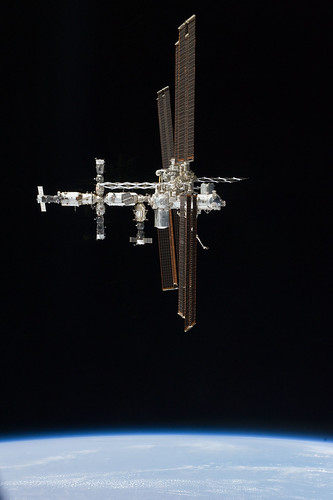
The ISS streaks across the sky over Sandbanks in Dorset, England. Image courtesy Chris Daborn/Flickr Creative Commons.
On some clear nights, if looking up at the night sky, one might catch a glimpse of bright shining objects moving rapidly across the atmosphere, flashing in the dark like a collection of short-lived falling stars. This object is the International Space Station, its hulking football-field-sized metal frame and solar panel array reflecting light from the sun back to Earth.
On Tuesday, March 25th, 2014, American astronaut Steve Swanson and two Russian cosmonauts blast off in Russia’s Soyuz spacecraft, heading to the International Space Station (or ISS for short) to take their place as part of the crew for six months. NASA joyfully tweeted through their NASA_Astronauts Twitter handle, “And follow #Swanny as he becomes first @NASA_Astronaut to Instagram from space!”
Not only will Steve “Swanny” Swanson Instagram from orbit aboard the ISS, he and his fellow crew mates use the internet, heat up their food, and breathe oxygen pumped throughout the station. All these tasks require power, but in space there are no coal plants or fossil-fuel burning electric plants, which contribute to global warming and dramatic upheaval for life where these kinds of energies do exist here on Earth. Instead, the ISS relies on the aforementioned solar array of eight panels to generate all energy needs during the typical sixth month stay of an astronaut on the ISS, which has been inhabited continuously by human crew members since November 2nd, 2000.
That means for over a decade, the ISS has relied solely on space-based solar power to operate.
Similarly, all satellites in orbit – whether used for GPS, communications, or television – operate using solar power. In addition, NASA is developing the Orion spacecraft, a manned vehicle designed to help Americans return to the Moon and go beyond – to Mars, asteroids, and wherever else we can reach. The Orion spacecraft, as a deep space vehicle, cannot depend solely on the initial forward momentum it receives from launch, and so will be equipped with solar panels to help propel itself to its destinations around the solar system. NASA has partnered with various American aerospace companies, such as Boeing, Alliant Tech Systems (ATK), and Lockheed Martin to produce flexible, large scale solar arrays for the Orion spacecraft.
American space-based solar power (SBSP) is already here. The difference between the kind of space-based solar power in use already and the kind of space-based solar power as a solution to the United States’ energy needs is where that power generated is used. Current SBSP stays in space, powering thousands of satellites and the ISS. Future SBSP would be converted to microwaves and beamed down for use on Earth.

The ISS over Earth, with its long solar panel array clearly visible. Image courtesy NASA/Flickr Creative Commons
Currently the ISS solar array generates about 90 kilowatts of electricity, enough to power roughly 20 typical American households. This array is 240 feet across, almost 30 feet longer than a Boeing 777 wingspan. While that’s an impressive amount of power, a SBSP station based on the ISS model of solar array would need to be enormous, as large as 10 kilometers, to provide any meaningful amount of energy for Americans.
As part of their work on NASA’s Orion spacecraft, the aerospace arm of American engineering company ATK has created what they call their UltraFlex arrays, which are circular, smaller and lighter than conventional rectangular arrays. Smaller, lighter, more flexible arrays means more bang for the buck as far as solar energy production, which would greatly benefit plans for a space-based solar power station beaming down energy for use by the United States on a large scale.
The man with that plan is former NASA employee John Mankins. He has proposed SPS-ALPHA, an acronym for Solar Power Satellite via Arbitrarily Large Phased Array. The defining feature of Mankins’ plan is his unique design for the solar array. Instead of panels, he envisions a goblet-shaped structure made up of small thin-film mirrors instead of photovoltaic cells, which would be more flexible and easier to assemble. Such a structure could be folded up and unfurled in space, “like a Pringles can unfolding,” according to David Schiminovich, associate professor of astronomy at Columbia University and a lead scientist on NASA’s current GALEX and upcoming James Webb space telescopes. This design is biomimetic, meaning it draws inspiration for its form and function from organic systems.
Says Mankins, “It intends to imitate how semi-autonomous insects operate, like hives of bees or colonies of ants. Everything is done on ID tags or barcodes. Every piece knows who the other piece is, and how it’s doing, and if it wants to be repaired, or if it wants to be left alone.”
In the official 2012 report on SPS-ALPHA, Mankins asserts that up to 1000-2000 mega-watts of solar power (that’s over 10 thousand times more than the ISS currently produces) could be generated per satellite, which translates to roughly 240,000-480,000 homes. He claims that up to 90 percent of the planet could be served by SPS-ALPHA satellites pointing to various locales around the world, though not all at once.

A SPS-ALPHA concept illustration. Image courtesy John Mankins and Artemis Corporation / http://i2.cdn.turner.com/cnn/dam/assets/131112051242-alternative-energy-space-lazer-horizontal-gallery.jpg
The estimate to build the final, fully operational satellite station is $20 billion, ten times more than Congress authorized just for research alone on SBSP in 1998. The study on the concept found that SPS-ALPHA “delivered close to commercial results (e.g., less than 20¢ per kW-hr) with technologies currently in the laboratory, and competitive commercial energy (e.g., less than 10¢ per kW-hr) with selected improvements in key technologies.”
Solar power is seen as a green energy technology, and SPS-ALPHA reports that “It would have a near zero ‘carbon footprint’ and facilitate reaching greenhouse gas (GHG) emission reduction goals.” However, Schiminovich warns that solar power is not necessarily the green energy savior its supporters purport it to be: “Some people worry about the materials in solar cells.” He explains, “They are usually made of silicon, which has to be manufactured, usually using fossil fuels. Also, some of them contain things like arsenic and gallium, so disposing of the panels [and the extra materials used on production] becomes a potential issue. In fact there are bans on solar cells that contain environmentally bad things in some places, like California.” As much good clean power as SBSP might be able to provide to a planet desperate for energy, many would balk at putting more “space junk” up in orbit that is damaging to the environment by means of its material production.
Still, with Mankins’ plans for SPS-ALPHA to launch as soon as 2025 along with current American ventures into SBSP that are already hard at work and have been for over two decades, space-based solar power for the United States is becoming more and more a reality. In the next ten years, we could very well have such a station powering the country, perhaps glimmering in the twilight sky when the sun’s rays reflect off it, a companion to the International Station already up there gleaming in the sun.